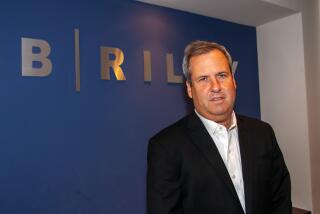Killinger’s Game: Develop Products to Assist ‘Joe Lunch Bucket’
- Share via
SEATTLE — When Kerry Killinger took over as chief executive of Washington Mutual Inc. in 1990, his background as a securities analyst seemed to make him uniquely suited for the job of dressing up the century-old Seattle-based thrift for a quick sale.
Instead, Killinger, now 47, has turned Washington Mutual from prey to predator. Thursday’s offer to acquire Great Western Financial in a friendly $6.6-billion merger follows Washington Mutual’s acquisition last year of Irvine-based American Savings Bank for $1.7 billion, and a host of other acquisitions that together could make the Seattle firm the nation’s largest thrift.
In an era when thrifts are trying to broaden their reach beyond their traditional role as mortgage lenders and look more and more like commercial banks, Killinger has built an empire through aggressive acquisitions and by finding new ways to serve the average consumer.
“He develops products aimed at Joe Lunch Bucket. It’s a McDonald’s strategy,” said Jay Tejera, an analyst for Minneapolis securities house Dain Bosworth.
Following 19 acquisitions in the last five years, Washington Mutual’s assets have climbed eightfold to $44 billion. They will total $87.8 billion if the Great Western deal is completed, although rival H.F. Ahmanson & Co., parent of Home Savings of America, promises to pursue its bid for Great Western.
Robert Bass, the Texas investor who controlled American Savings and is now Washington Mutual’s largest shareholder, endorsed the marriage with Great Western, but Ahmanson is hoping that other Washington Mutual shareholders will be less enthusiastic.
Fidelity Investments, the Boston-based mutual fund giant, is a major stockholder of all three companies, holding 7.5% of Washington Mutual, 6% of Great Western and 2.5% of Ahmanson.
William Rubin, a Fidelity analyst and fund manager, told American Banker earlier this week that the Ahmanson offer was very attractive. Thursday he said the same thing about the Killinger offer.
Washington Mutual, he said, “brings to the table a different set of capabilities. They can’t cut as much in costs, but they look better on the revenue-growth side.”
His main concern is that Killinger does not raise his bid to the point where the deal would be “dilutive” to Washington Mutual earnings. He would not offer a dollar figure as to where that point might be.
Wall Street, though, has generally approved of the discipline Killinger has imposed while pursuing his acquisition strategy. Problem loans, which totaled 3.5% of assets when Killinger took over, have shrunk to less than one-fourth that level. Net income and return on assets have soared.
Rather than chasing well-heeled consumers with high-yielding CDs and cut-rate consumer loans the way large-city banks have, Killinger is after the average account holder with a few thousand dollars in the account.
Washington Mutual was among the first thrifts to offer free checking accounts, and used heavy advertising to push the product. Last year, the thrift’s banking subsidiaries added 116,434 checking accounts, boosting their account base by 24%.
The free checking program is simpler for employees and customers to understand, said Stephen DiPadua, manager of American Savings’ Beverly Hills branch. “It’s free checking with no strings attached--no minimum deposits, no monthly fees,” he said. “The customers really appreciate that.”
Those new accounts provide the thrift with deposits on which it doesn’t have to pay interest. And those new customers become an important market for its mortgage loans, mutual funds and insurance annuities.
“Banks tend to be conservative; they tend to follow the leader,” said Andrew Singer, head of Mamaronek, N.Y.-based Bank Insurance Market Research Group. By pioneering the push by thrifts into new areas like investments and insurance, said Singer, “Killinger has been an innovator and leader.”
Killinger has a reputation for moving fast. After taking over Washington Mutual seven years ago, he set clear financial goals for the organization and promoted executives based on their success in reaching those goals.
Businesses that performed poorly--including Murphey Favre, a brokerage subsidiary where Killinger built his career--saw sharp cutbacks. Return on assets soared to become among the industry’s best.
Most importantly, Killinger has impressed analysts with his ability to maintain a clean balance sheet even as he swallows larger and larger prey.
“Killinger is not a banker. He is not a thrift person,” analyst Tejera said. “And that is a huge advantage.”
Like traditional bankers, Killinger plays an active role in the local community. He is on the boards of several nonprofits and insists he tries to “balance not only the needs of shareholders but also the needs of our community and employees.”
But, like a good securities analyst, he doesn’t lose sight of the bottom line.
Tejera figures that Killinger cuts non-interest expenses by 55% in the first year following a typical acquisition. The bulk of those savings come from laying off employees.
At Great Western, Killinger has promised to make a 37% cut in non-interest expenses, less in proportional terms than many of his past cuts, but almost as much as the roughly 40% trim that renowned cost-cutter Wells Fargo Bank is making at the former First Interstate Bancorp.
Times staff writer Thomas S. Mulligan contributed to this story. Helm reported from Seattle, and Mulligan from New York.
(BEGIN TEXT OF INFOBOX / INFOGRAPHIC)
White Knight
Washington Mutual Inc. topped H.F. Ahmanson & Co.’s bid for Great Western Financial Corp., on Thursday, offering $6.6 billion. The deal sets up a potential bidding war for Great Western. A look at what may be next:
THE COMPANIES
* H.F. Ahmanson & Co.: It’s highly likely that the thrift will come back with a second bid for Great Western. If the value of Great Western’s stock continues to climb, Ahmanson could face competition from a third suitor, analysts say.
* Washington Mutual Inc.: Chief Executive Kerry Killinger said his thrift will immediately start working with Great Western’s management to ensure their marriage goes off without a hitch. The transaction has been approved by the boards of both banks.
* Great Western Financial Corp.: Managers will scramble to present the terms of the thrift’s deal with Washington Mutual to shareholders, many of whom should be pleased with the offer because they were convinced Great Western was worth more than Ahmanson’s original bid.
STOCKHOLDERS
Great Western’s shareholders, dominated by big institutions, will have to decide whether they want Ahmanson or Washington Mutual stock in return for their Great Western holdings. On Thursday, Great Western shares jumped $1.875 to $46.875, while Ahmanson shares fell $1.25 to $40.75, both on the New York Stock Exchange. Washington Mutual shares eased just 25 cents to $53 on Nasdaq.
EMPLOYEES
It is likely that Great Western employees are more optimistic about Thursday’s deal, analysts say, because of a promise by Great Western to retain employees based on merit and a plan by Washington Mutual to add four Great Western managers to its board.
CONSUMERS
New bank-like products are expected and branches will be closed as a result of either deal.
TOP 10 THRIFTS
A marriage of Washington Mutual and Great Western Financial would create a savings and loan that would dwarf its competitors. Largest U.S. thrifts based on assets, in billions:
Institution: Total assets, in billions
Washington Mutual/Great Western: $87.8
H.F. Ahmanson & Co.: 49.9
Golden West Financial: 37.7
First Nationwide: 30.9
Dime Bancorp: 19.5
Standard Federal Bancorp: 15.7
Glendale Federal: 15.6
Charter One Financial: 13.9
GreenPoint Financial: 13.3
Sovereign Bancorp: 12.4
Sources: Edward Carpenter, chairman and chief executive of Carpenter & Co.; Times and wire reports. Researched by JENNIFER OLDHAM / Los Angeles Times
More to Read
Inside the business of entertainment
The Wide Shot brings you news, analysis and insights on everything from streaming wars to production — and what it all means for the future.
You may occasionally receive promotional content from the Los Angeles Times.










